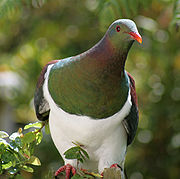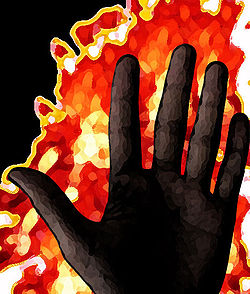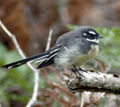
Maui (Maori mythology)
Encyclopedia

Maori mythology
Māori mythology and Māori traditions are the two major categories into which the legends of the Māori of New Zealand may usefully be divided...
, Māui is a culture hero
Culture hero
A culture hero is a mythological hero specific to some group who changes the world through invention or discovery...
famous for his exploits and his trickery.
Māui's birth
The offspring of TūTumatauenga
In Māori mythology, Tū or Tūmatauenga is one of the great gods, and the origin of war. All war-parties were dedicated to him, and he was treated with the greatest respect and awe. He is usually a son of the primordial parent, sky and earth...
(humankind) increased and multiplied and did not know death until the generation of Māui-tikitiki (Biggs 1966:449). Māui is the son of Taranga
Taranga (Maori mythology)
In Māori mythology, Taranga is the mother of Māui. Her husband is Makeatutara. Māui was born prematurely, so Taranga wrapped his body in her hair and threw him into the waves. Some sea-creatures cared for him, hiding him in kelp until a storm sent him back to the beach...
, the wife of Makeatutara. He has a miraculous birth—his mother throws her premature infant into the sea wrapped in a tress of hair from her topknot
Topknot
Topknot may refer to:* A hairstyle or haircut, historically prevalent in Asia:**Chonmage, a traditional Japanese haircut worn by men**Sangtu, a knot of hair that married men of the Joseon Dynasty wore in Korea.**Sikha, worn by orthodox Hindus....
(tikitiki)—hence Māui is known as Māui-tikitiki-a-Taranga. Ocean spirits find and wrap the child in seaweed. Māui's divine ancestor, Tama-nui-ki-te-rangi (or Rangi) then takes the child and nourishes it to adolescence.
Finds his mother and brothers
Māui emerges from the sea and goes to his mother's house, finding there his four brothers, Māui-taha, Māui-roto, Māui-pae, and Māui-waho. Māui's brothers at first are wary of the new-comer but, after he performs several feats such as transforming himself into different kinds of birds, they acknowledge his power and admire him.At first Taranga does not recognise Māui as her child. At first she denies him, saying, "This is the first time I have seen you. Get out of this house. You are not my child." Reluctantly, Māui moves towards the door, muttering as he goes, "I'll go, then, if you say so. Perhaps I am the child of a stranger, but I did believe that I was born near the ocean, wrapped by you in your girdle, and cast into the sea. And I was rescued by Rangi, and nurtured by him in the sky, where I used to gaze down and watch this house, and listen to your voices. Indeed, I know the names of your children. There is Māui-to-the-side, and Māui-within; there is Māui-opposite, and Māui-without. And I say to you that I am Māui-the-girdle-of-Taranga!" Then, at last, Taranga calls out to him, "You are indeed my last-born, the child of my old age, Māui-the-girdle-of-Taranga" and she kisses him and takes him to sleep in her own bed.
At first the older brothers are jealous and suspicious of the newcomer, saying, “We were conceived in wedlock, and born on the wide-wefted sleeping mat of legitimacy, and we are not asked to sleep with our mother. Yet this abortion, cast into the sea and nursed by seaweed, returns to life and is called to her couch. How are we to know he is really our brother?" After a while though, the brothers accept that the newcomer is one of them (Biggs 1966:449, Tregear 1891:233).
Restrains the sun
Māui takes the jaw-bone of his ancestress Muri-ranga-whenua and uses it as a weapon in his first expedition. This is to snare the Sun and make it go slower because the days were too short for people to get their work done. With the help of his brothers, Māui nooses the Sun and beats him severely with the jaw-bone club until the Sun promises to go slower in future (Tregear 1891:233-234).Hauls up the North Island
His next exploit is to haul up land from the depth of the ocean—here he again uses the jaw-bone, this time as a fish-hook. Māui, using blood from his nose for bait, hauls the great fish up from the depths. When it emerges from the water Māui goes to find a priest to perform the appropriate ceremonies and prayers, leaving his brothers in charge of the fish. They, however, do not wait for Māui to return but begin to cut up the fish (to grab their share), which immediately begins to writhe in agony, causing it to break up into mountains, cliffs and valleys. If the brothers had listened to Māui the island would have been a level plain and people would have been able to travel with ease on its surface. Thus the North IslandNorth Island
The North Island is one of the two main islands of New Zealand, separated from the much less populous South Island by Cook Strait. The island is in area, making it the world's 14th-largest island...
of New Zealand is known as Te Ika-a-Māui
North Island
The North Island is one of the two main islands of New Zealand, separated from the much less populous South Island by Cook Strait. The island is in area, making it the world's 14th-largest island...
(The Fish of Māui) (Tregear 1891:234).
His canoe the South Island
In Māori traditions from the South IslandSouth Island
The South Island is the larger of the two major islands of New Zealand, the other being the more populous North Island. It is bordered to the north by Cook Strait, to the west by the Tasman Sea, to the south and east by the Pacific Ocean...
of New Zealand, Māui’s canoe became the South Island, with Banks Peninsula
Banks Peninsula
Banks Peninsula is a peninsula of volcanic origin on the east coast of the South Island of New Zealand. It has an area of approximately and encompasses two large harbours and many smaller bays and coves...
marking the place supporting his foot as he pulled up the extremely heavy fish. Therefore, besides Te Wai Pounamu
Te Wai Pounamu
Te Wai Pounamu is a Māori name for New Zealand's South Island which is also sometimes referred to as Te Waka a Maui , from mythology....
, another Māori
Maori language
Māori or te reo Māori , commonly te reo , is the language of the indigenous population of New Zealand, the Māori. It has the status of an official language in New Zealand...
name for the South Island is Te Waka a Māui (The canoe of Māui).
Discovers the secret of fire

Mahuika
Mahuika is a Māori fire deity. Generally, Mahuika is female. In some versions, she is the younger sister of Hine-nui-te-pō, goddess of death. It was from her that Māui obtained the secret of making fire. She married Auahi-Turoa and together they had five children, named for the five fingers on the...
the Fire-goddess and learn the secret art of obtaining fire. He visits her but his tricks make her furious and, although he obtains the secret of fire, he barely escapes with his life. He transforms himself into a hawk
Swamp Harrier
The Swamp Harrier also known as the Marsh Harrier, Australasian Harrier, Kāhu, Swamp-hawk or New Zealand Hawk is a large, slim bird of prey in the family Accipitridae.-Description:...
, but to no avail for Mahuika sets both land and sea on fire. Māui prays to his great ancestors, Tāwhirimātea
Tawhirimatea
In Māori mythology, Tāwhirimātea is the god of weather, including thunder and lightning, wind, clouds and storms. He is a son of Papatūānuku and Ranginui...
and Whatiri-matakataka
Whaitiri
In Māori mythology, Whaitiri is a female deity, a personification of thunder, and the grandmother of Tāwhaki and Karihi. Whaitiri is the granddaughter of Te Kanapu, and the great-granddaughter of Te Uira, both of whom are personified forms of lightning...
who answer with pouring rain and extinguish the fire. Māui soon after goes out fishing with Irawaru, the husband of Hina
Hina
Hina is the name of several different goddesses and women in Polynesian mythology. In some traditions, the trickster and culture hero Maui has a wife named Hina, as do the gods Tane and Tangaroa. Hina is often associated with the moon....
, Maui's sister. They disagree when their fishing lines get tangled and, when they return to shore, Māui turns Irawaru into a dog. Hina is distraught and throws herself into the sea, but she does not die. (Tregear 1891:234).
Finds his father
Māui stays with his mother and brothers. Each morning Taranga disappears. Taking the shape of a kererūKereru
The New Zealand Pigeon or kererū is a bird endemic to New Zealand. Māori call it Kererū in most of the country but kūkupa and kūkū in some parts of the North Island, particularly in Northland...
(wood pigeon) Māui descends after her and finds her with his father, Makeatutara. When Māui’s father is performing the baptismal ceremonies for Māui he makes a mistake in the incantations and this ill omen leads, in the end, to the death of Māui (Tregear 1891:233).
Seeks immortality

“Who could that be?” asks Māui. “Your ancestress Hine-nui-te-pō
Hine-nui-te-po
Hine-nui-te-pō is a goddess of night and death and the ruler of the underworld in Māori mythology. She is a daughter of Tāne. She fled to the underworld because she discovered that Tāne, whom she had married, was also her father. The red colour of sunset comes from her.All of the children of Rangi...
(Great woman of the nightworld). You can see her flashing there on the horizon.” “Is she as strong as the sun?” asks Māui. “I trapped him and beat him. Is she greater than the sea, which is greater than the land? Yet I have dragged land from it. Now let us see whether we will find life or death.”
His father answers, “You are right, my last-born, and the strength of my old age. Go, find your ancestress who lives at the side of the sky.”
“What does she look like?” asks Māui.
“The red flashing in the western sky comes from her,” says the father. “Her body is like a human being, but her eyes are greenstone, her hair sea-kelp
Kelp
Kelps are large seaweeds belonging to the brown algae in the order Laminariales. There are about 30 different genera....
, and her mouth is like a barracouta's
Barracuda
The barracuda is a ray-finned fish known for its large size and fearsome appearance. Its body is long, fairly compressed, and covered with small, smooth scales. Some species could reach up to 1.8m in length and 30 cm in width...
mouth” (Biggs 1966:449).
Māui, undaunted, sets out westward, with his companions, to the home of Hine-nui-te-pō. In some versions, his companions are the smallest birds of the forest, the tomtit
Tomtit
The Tomtit, Petroica macrocephala, is a small passerine bird in the family Petroicidae, the Australian robins. It is endemic to the islands of New Zealand, ranging across the main islands as well as several of the outlying islands. It has several other English names as well. There are several...
, the robin
Petroicidae
The bird family Petroicidae includes roughly 45 species in about 15 genera. All are endemic to Australasia: New Guinea, Australia, New Zealand and numerous Pacific Islands as far east as Samoa. For want of an accurate common name, the family is often called the Australasian robins. Within the...
, the grey warbler
Grey Warbler
The Grey Gerygone , more commonly known in New Zealand as the Grey Warbler or Riroriro, is a species of insectivorous bird in the Acanthizidae family endemic to New Zealand.Its natural habitat is temperate forests....
, and the fantail
Fantail
Fantails are small insectivorous birds of southern Asia and Australasia belonging to the genus Rhipidura in the family Rhipiduridae...
. In other versions, the companions are his brothers. He finds Hine asleep with her legs apart and he and his companions see sharp flints of obsidian
Obsidian
Obsidian is a naturally occurring volcanic glass formed as an extrusive igneous rock.It is produced when felsic lava extruded from a volcano cools rapidly with minimum crystal growth...
and greenstone between her thighs. “Now,” Māui tells his friends, “when I go into the body of this old woman, do not laugh at me. Wait until I come out again from her mouth. Then you may laugh as much as you want.”
“You will be killed!” was all the companions could say.
“If you laugh I will indeed be killed. But if I pass right through her body I will live, and she will die.”
Then he readied himself, winding the cord of his battle club tightly round his wrist and casting aside his garment. As Māui began his task, the cheeks of his watching friends puckered with suppressed laughter. As his head and arms disappear, one of his brothers - or the fantail - can hold back no longer and bursts out laughing. The old lady wakes, opens her eyes, claps her legs together and cuts Māui in two. Now Māui has become the first being to die and, because he has failed in his task, all human beings are mortal. The goddess keeps her position at the portal to the underworld through which all humans must travel (Biggs 1966:449-450, Tregear 1891:234).
Māui and Rohe
In a rare version, a goddess named RoheRohe (mythology)
In a tradition of the Moriori people of the Chatham Islands, Rohe is the wife of the demi-god Māui. Beautiful Rohe was a sister of the sun, and her face shone. A quarrel arose after Rohe remarked that Māui's face was ugly. Māui then decided that they should change faces. Afterwards Māui used magic...
is Māui's wife. He mistreats her in a cruel and unusual way. He wishes her to exchange faces with him because she is beautiful and he is ugly. When she objects he gets his way by reciting an incantation over her as she is sleeping. When she awakes and realises what has happened she leaves this world and goes down into the underworld where she becomes a goddess of death (Tregear 1891:421).
Names and epithets
- Māui-tikitiki ("Māui the top-knot")
- Māui-tikitiki-a-Taranga ("Māui the top-knot of Taranga")
- Māui-pōtiki ("Māui the last born”).
See also
- Maui (Hawaiian mythology)Maui (Hawaiian mythology)In Hawaiian mythology, Māui is a culture hero who appears in several different genealogies. In the Ulu line he is the son of Akalana and his wife Hinakawea . This couple has four sons, Māui-mua, Māui-hope, Māui-kiikii and Māui-a-kalana. Māui-a-kalana's wife is named Hinakealohaila; and his son is...
- Maui (Mangarevan mythology)Maui (Mangarevan mythology)In Mangareva, Maui hauls the land up from the sea, and ties the sun with tresses of hair. His father was Ataraga; his mother, Uaega. There were eight Maui: Maui-mua, Maui-muri, Maui-toere-mataroa, Tumei-hauhia, Maui-tikitiki-toga, Maui-matavaru, Maui-taha, Maui-roto. Maui the eight-eyed is the hero...
- Maui (Tahitian mythology)Maui (Tahitian mythology)In the mythology of Tahiti, Maui was a wise man, or prophet. He was a priest, but was afterwards deified. Being at one time engaged at the marae , and the sun getting low while Maui's work was unfinished, he laid hold of the hihi, or sun-rays, and stopped his course for some time...
- Maui (Tongan mythology)Maui (Tongan mythology)In Tonga, Maui drew up the Tongan Islands from the deep: first appeared Lofaga and the other Haapai Islands, and finally Vavau. Maui then dwelt in Tonga. Maui had two sons: the eldest, Maui Atalaga, and the younger Kisikisi. The latter discovered the secret of fire, and taught people the art of...
- Ti'iti'i (Samoan mythology)Ti'iti'i (Samoan mythology)In Samoan legend, Ti'iti'i is the son of Talaga. He goes down to the earthquake-god, Mafui’e, who dwells in the underworld, and, receiving some fire from him, takes it back to the world, and begins to cook. Mafui’e then comes and blows on the fire, scattering it, and breaking up the oven. Ti'iti'i...
- MauisaurusMauisaurusMauisaurus is a genus of plesiosaur that lived during the Late Cretaceous period around 80 to 69 million years ago in what is now New Zealand. It was the largest plesiosaur, and perhaps the largest marine reptile in New Zealand waters at the time. Mauisaurus haasti is the only known species of the...
- New ZealandNew ZealandNew Zealand is an island country in the south-western Pacific Ocean comprising two main landmasses and numerous smaller islands. The country is situated some east of Australia across the Tasman Sea, and roughly south of the Pacific island nations of New Caledonia, Fiji, and Tonga...
plesiosaurPlesiosaurPlesiosauroidea is an extinct clade of carnivorous plesiosaur marine reptiles. Plesiosauroids, are known from the Jurassic and Cretaceous Periods...
named after Maui.

